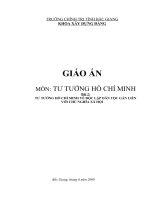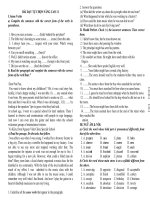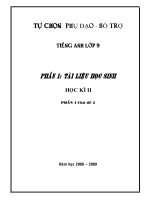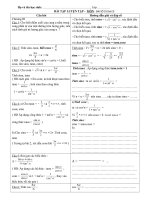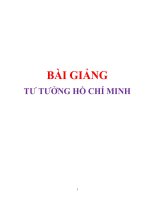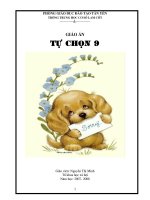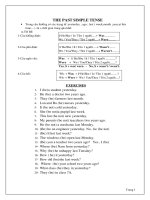Bài giảng tu chon anh
Bạn đang xem bản rút gọn của tài liệu. Xem và tải ngay bản đầy đủ của tài liệu tại đây (758.1 KB, 65 trang )
NS: 20/8/10
ND:25/8/10
Week 1 Lesson 1 : TO BE AND GREETING
I. objectives: By the end of the lesson, sts will be able to know about the verb “to be” and how
to introduce about themselves.
II. Teaching aids: poster.
III. practice:
A. Caucus chug too thường gape throng Teeing An và động từ To Be:
Subjects (Chủ từ) Động từ To Be:
I : tôi I am
He : anh ấy, ông ấy He is
She : cô ấy, chò ấy She is
It : nó It is
We : chúng ta We are
You : bạn You are
They : họ, chúng nó They are
Lưu ý:
+ Chủ từ He, She, It dùng cho số ít (1 người hoặc 1 vật).
+ Chủ từ We, You, They dùng cho số nhiều (2 người hoặc 2 vật trở lên).
+ Động từ To be “is” được dùng cho số ít.
+ Động từ To be “are” được dùng cho số nhiều.
B. Caucus câu chào hỏi thông thường:
Hi/ Hello
How are you? Fine, thanks.
My name is......... = I’m...........
Good morning/ afternoon..................
C. Giới thiệu về bản thân:
I’m + tuổi (years old).
I live in + xã/ thành thò/ vùng......
on + tên một con đường.
at + số nhà, số đường.
D. Giới thiệu người khác:
This is + tên người khác./He is......./She is....../They are..........
*Exercises
I. Hãy hoàn tất các câu sau:
a. Hello, I ___________ Mai.b. I’m ten ____________ old.
c. This _______ Lan.d. How are ________?
e. My name _________ Huong.
f. I live ________ Nguyen Hue Street.g. He ________ Mr. Tan.
II. Hãy chọn một throng các đáp án cho sẵn:
1. Mai _____ a teacher.a. is b. am c. are d.
2. I live _____ Gao Giong.a. in b. on c. at d.
3. They _____ in class.a. is b. am c. are d.
III. Dùng đại từ nhân xưng để thay thế cho các từ gạch dưới:
GI¸O ¸N Tù CHäN ANH 6- GV: chu THÞ nHung
1
1. Thu and Lan are students.
2. My father and I are teachers.3. My book is here.
4. His pencils are there.
5. Are you and Nam a student?
IV.Home work
- Redo all the Exs and traslate them.
……………………………………………………………………………………….
NS: 28/8/10
ND: 1/9/10
Week 2 Lesson 2 : QUESTION WORDS
I. objectives: By the end of the lesson, sts will be able to know about the “wh”
II. Teaching aids: poster.
III. practice:
A. Caucus từ dùng để hỏi thường gặp:
What: cái gì
Where: ở đâu
How: thế nào các từ này thường nằm ở đầu câu hỏi
When: khi nào
Who: ai
II. Caucus câu hỏi và trả lời về bản thân:
1. What’s your name? My name is......./ I’m........
2. How are you? I’m fine, thanks.
3. How old are you? I’m...........
4. Where do you live? I live in/ on/ at...........
5. How do you spell your name? It’s...........
*Exercises
I. Hãy dặt câu hỏi cho các câu trả lời sau:
1. ___________________________? - My name’s Tam.
2. ___________________________? - I’m eleven.
3. ___________________________? - I’m fine, thanks.
4. ___________________________? - I live in Hue.
5. ___________________________? - It’s L-I-E-N.
II. Hãy sử dụng các từ cho sẵn để đặt câu:
1. I/ live/ Ly Thuong Kiet Street.2. morning/ Miss Huong.
3. old/ you?4. He/ ten/ old.
5. What/ name?
III. Đọc đoạn hội thoại sau và điền vào chổ trống:
Hung: Phuong! ________ (1).
Phuong: Hung! What a surprise! _________ (2).
Hung: I’m fine. _______(3) you?
Phuong: Great. It ______ (4) to ______ (5) you. This ______ (6) Minh.
GI¸O ¸N Tù CHäN ANH 6- GV: chu THÞ nHung
2
Hung: Hi, Minh. _____ (7) old are you?
Minh: ______(8) twelve years old.
Hung: Me, too. And Phuong _____(9) years old.
IV.Home work
-Redo all the Exs and translate them
------------------------------------
NS: 1/9/10
ND:8 /9/10
1. Week: 3
TO BE IN QUESTIONS
I. Cách thành lập câu hỏi có động từ To Be:
* Ta đem động từ To Be: am/ is/ are ra đặt trước chủ từ.
Ex: It is a book.
Is it a book?
He is a teacher.
Is he a teacher?
This is Nam.
Is this Nam?
II. Động từ To Be throng câu “What is this/ that?”:
- Ta dùng câu hỏi “What is this/ that?” để hỏi về 1 vật hoặc 1 đồ vật.
- Câu trả lời được bắt đầu là: It’s a/ an...........
- Mạo từ “a” được dùng trước một danh từ.
- Mạo từ “a” biến thành “an” khi các danh từ bắt đầu bằng một throng các
nguyên âm sau: a, e, i, o, u.
Ex: What is this?
It’s a book.
What is that?
It’s an eraser.
III. Động từ To Be throng câu “What are these/ those?”:
- Ta dùng câu hỏi “What are these/ those?” để hỏi về nhiều vật hoặc đồ vật.
- Câu trả lời được bắt đầu là: They’re + N số nhiều...........
- Danh từ số nhiều là danh từ được thêm “s” vào tận cùng.
- Tuy nhiên, ta phải thêm “es” khi các danh từ có chữ cái tận cùng là: ch,
sh, x, s, o, z.
Ex: What are these?
They’re books.
What are those?
They’re couches.
IV. Động từ To Be throng câu “There is/ There are.............”:
There is + a/ an + N (in singular).
GI¸O ¸N Tù CHäN ANH 6- GV: chu THÞ nHung
3
There are + N (in plural).
* Khi muốn chuyển các câu trên sang câu hỏi ta đem động từ To Be ra đầu
câu.
Ex: There is a book on the table.
Is there a book on the table?
Ex: There are twenty classrooms in the school.
Are there twenty classrooms in the school?
Exercises
I. Hãy điền vào chổ trống với dạng đúng của động từ To Be:
1. What’s _____ this?
2. We ________ classmates.
3. That ________ a book.
4. The children _______ fine.
5. What _____ her name?
II. Hãy trả lời các câu hỏi sau:
1. What is that? __________________ table.
2. Where do you live? _________________ Ha Noi.
3. What are those? __________________ pens.
4. Is that your bag? Yes. _______________ .
5. What is this? __________________ eraser.
III. Chuyển các câu hỏi sau sang số nhiều:
1. This is a telephone. __________________
2. That is a house. __________________
3. There is a table. __________________
4. What is this? __________________
5. It is a desk. __________________
IV. Hãy sửa lỗi cho các câu sau:
1. We are fine, thanks you.
2. Where are you live?
3. I’m ten year old.
4. I live in Le Loi street.
5. This is books and those are pen.
……………………………………………………………………
………….
NS: 20/8/10
ND:22/8/10
Lesson 3: Do exercises
Exercise 1: Điền vào khoảng trống bằng một từ thích hợp.
Mrs.Lyn: Good (1) ……………………,Mr.Hug
Mr.Hug Oh, (2) …………afternoon, Mrs.Lyn
GI¸O ¸N Tù CHäN ANH 6- GV: chu THÞ nHung
4
How (3)………….you ?
Mrs. Lyn : I’m so (4) ………………, thanks. And you ?
Mr. Hug : Fine, (5)……………….
Exercise 2. Điền vào khoảng trống bằng một từ thích hợp.
Elyne : Hi, (1) …………..!
Bob : (2) ………….., Elyne ! (3)……………..are you ?
Elyne : (4) ………………well, thank you. And you ?
Bob : Not (5) ………………..well, thanks.
Elyne : Oh, how’s your mother ?
Bob : She’s fine, (6)…………………..
Exercise 3. Hãy sửa lỗi sai throng các câu sau đây .
Helo. My name’s Minh. What your name ?
Hello. My name’s Minh. What’s your name ?
2. Hi, Peter. My names Nam. It’s is nice to meet you.
…………………………………………………………
3. Be glade to meet you, to.
…………………………………………………………..
4. Hello, Lan. How’re are you ?
…………………………………………………………..
5. I’m am fine, thanks you. And you ?
……………………………………………………………
6. Not so bad, thank. How your father ?
……………………………………………………………..
7. She’s is fine, thanks you. And your mother ?
……………………………………………………………….
8. Oh, she not very well today. She ill.
………………………………………………………………
9. Am sorry to hear that. Byes for now.
………………………………………………………………..
See you late !
GI¸O ¸N Tù CHäN ANH 6- GV: chu THÞ nHung
5
Week: 4 Lesson 4 : POSSESSIVE ADJECTIVES
I. Caucus tính từ sở hữu tương ứng các chủ từ:
Subjects : Chủ từ Pos. Adj : Tính từ sở hữu
I my : của tôi
He his : của anh ấy
She her : của cô ấy
It its : của nó
We our : của chúng ta
You your : của bạn
They their : của họ
* Caucus tính từ sở hữu cần có danh từ theo sau nó; khi dòch sang Teeing Việt
ta phải dòch danh từ đó trước.
Ex: This is his school (Đây là trường của anh ấy).
pos.adj N
II. Sở hữu cách thay cho tính từ sở hữu:
- Để diễn tả sự sở hữu, ta dùng dấu sở hữu cách (‘s) để thay thế cho
những tính từ sở hữu không có ở bảng trên.
- Thường ta dùng sở hữu cách sau các tên riêng (chỉ người).
Ex: He is Tom’s father. ( Ông ấy là bố của Tom).
Those are Lan’s books. ( Đó là những quyển sách của Lan).
- Sở hữu cách chỉ dùng cho danh từ chỉ người (đôi khi làcon vật), không
được dùng cho đồ vật.
- Muốn sở hữu cho đồ vật, ta dùng “of” thay thế cho dấu sở hữu ‘s.
Ex: The leg of the table.( Chân của cái bàn).
III. Động từ To Be throng câu “Who is this/ that?”:
- Ta dùng câu hỏi “Who is this/ that?” để hỏi về 1 người .
- Câu trả lời được bắt đầu là: This/ That is + tên 1 người (hoặc pos.adj +N).
- Đôi khi câu trả lời bắt đầu là: He/ She is + tên 1 người (hoặc pos.adj +N).
Ex: Who is this?
This is Van.
Who is that?
He is his father.
ExerciseI. Hãy điền các tính từ sở hữu thích hợp vào chổ trống:
1. What’s her name? _______ name is Xuan.
2. Is ____ name Tam? No. ________ name is Binh.
3. They are engineers. ________ names are John and Davie.
4. Is this your ruler? Yes. It is _______ ruler.
5. This is Nam and that is _______ book.
6. We are in classroom. ______ friends are, too.
7. My dog is intelligent. _______ name is Phen.
GI¸O ¸N Tù CHäN ANH 6- GV: chu THÞ nHung
6
8. Is that _______ teacher? No, this is my teacher.
9. There are four people in ________ family.
10. I and Lan are students of class 6A. ______ classroom is there.
II. Hãy đặt câu hỏi cho các từ gạch dưới:
1. My name is Linh.
2. It’s a school bag.
3. They are tables.
4. She is Miss Robinson.
5. Yes. That is Tam’s school.
6. Her name is Vy, not Lan.
7. I am eleven years old.
8. This is her sister.
9. No. She is Tuyet.
10. His father is 60 years old.
GI¸O ¸N Tù CHäN ANH 6- GV: chu THÞ nHung
7
NS: 20/8/10
ND:22/8/10
Week: 5 Lesson 5 : YES/ NO QUESTIONS
I. Dạng câu hỏi Yes/ No:
- Câu hỏi Yes/ No là dạng câu hỏi chỉ có 2 cách trả lời : Yes hoặc No.
- Throng câu trả lời phải xuất hiện 1 throng 7 chủ từ : I, He, She, It, We, You,
They.
- Throng câu trả lời No phải có “not”.
Ex: Is he a teacher?
Yes, he is.
Ex: Are Lan and Mai students in class 6A?
No, they are not.
II. Cách thành lập câu phủ đònh và nghi vấn có động từ To Be:
Affirmative: S + am/ is/ are..............
Negative: S + am/ is/ are not................
Interrogative: Am/ Is / Are + S............?
III. Động từ To Be throng câu “How many..............?”:
Form: S1: How many + N (in plural) + are there............?
S2: There is + a/ an + N (in singular).
There are + N (in plural).
Use: Hỏi/ đáp về có 1 hoặc nhiều người hoặc vật.
Ex: How many classroom are there?
There are 24 classrooms.
Ex: How many books are there?
There is a/ one book.
Exercises
I. Đổi các câu sau sang câu phủ đònh và nghi vấn:
1. This table is big.
2. They are chairs.
3. It’s a small house.
4. His school is in the country.
5. These are notebooks and books.
II. Trả lời những câu hỏi sau về bản thân bạn và gia đình bạn:
1. Are you a student?
2. Are there 6 people in your family?
3. Is your house big?
4. Is your father 40 years old?
5. Are you in class 6A1?
6. Is English easy for you?
GI¸O ¸N Tù CHäN ANH 6- GV: chu THÞ nHung
8
7. Is your sister 6 years old?
III. Hãy đổi các câu sau sang số nhiều:
1. This house is small.
2. Is it your pen? Yes, it is.
3. Is this couch big? No, it isn’t.
4. What is that? It is an eraser.
5. That is a desk.
………………………………………………………………………
……..
NS: 20/8/10
ND:22/8/10
Week: 6 Lesson 6 : THE PRESENT SIMPLE TENSE
1. Form: To be:
- Affirmative: S + V1…. S + am/is/are……
- Negative: S + do/does + not + V….. S + am/is/are + not…..
- Interrogative: Do/Does + S + V….? Am/Is/Are + S ….?
(I, We, You, They: do He, She, It: does)
2. Use:
a. Diễn tả một hành động hoặc một thói quen ở hiện tại (always, usually, often,
sometimes, occasionally, seldom, rarely, every…….)
Ex: I usually go to school in the afternoon.
b. Diễn tả một chân lí, một sự thật lúc nào cũng đúng.
Ex: The earth moves around the sun (Trái đất quay quanh mặt trời)
3. Đối với ngôi thứ ba số ít: (He, She, It):
a. Thêm “S” vào sau động từ thường.
Ex: Lan often gets up early in the morning.
b. Thêm “ES” vào sau các động từ tận cùng là: ch, sh, s, x, o, z.
Ex: He watches a lot of TV on Sundays
Exercises
I. Đổi các câu sau sang câu phủ đònh và nghi vấn:
1. He often gets up at 6.
2. They are teachers.
3. Mai always goes to school early.
4. We live in the country.
5. She likes school.
6. There is a couch in the room.
7. Nam has breakfast at 7:30 each morning.
8. These are pencils.
9. That is his teacher.
10. They usually get up 5.
GI¸O ¸N Tù CHäN ANH 6- GV: chu THÞ nHung
9
II. Chia động từ throng ngoặc cho đúng:
1. Thu often ______ (get) up at 4:30.
2. We _______ (watch) TV every night.
3. Tan and Lan ________ (play) games after school.
4. She _____ (have) lunch at 11.
5. Bin _____ (do) homework every night.
NS: 20/8/10
ND:22/8/10
Week: 7 Lesson 7 : REVISION
I. Chọn từ đúng để điền vào chổ trống:
1. Phong and Nam ____ ten years old.
a. am b. is c. are d. be
2. This id my sister. ______ name is Hanh.
a. My b. his c. Her d. Its
3. ______ is he? - He’s twenty.
a. How many b. How old c. How d. How long
4. _____ is that? - It’s a lamp.
a. Who b. How c. What d. Which
5. How many books are there? - There ______ one.
a. am b. is c. are d.
II. Kết hợp câu hỏi ở cột A và câu trả lời ở cột B:
A B
1. How are you? a. I live on Nguyen Hue Street.
2. What’s that? b. Yes. That is my pencil.
3. Where do you live? c. His name is Phong.
4. How old is Lan? d. I’m fine.
5. Is that your pencil? e. She is eleven.
6. How do you spell it? f. That is my sister.
7. What’s his name? g. It’s a stereo.
8. Who is this? h. M-A-I.
III. Điền từ vào chổ trống:
1. This is ______ armchair.
2. I live _______ a city.
3. There are four people ___ my family.
4. _____ is that? - It’s an eraser.
5. She usually ______ up at 6:00.
GI¸O ¸N Tù CHäN ANH 6- GV: chu THÞ nHung
10
Week: 4 Lesson 8 : REVISION
I. Điền từ vào chổ trống:
This ____ my family. There ______ five people ____ my family: my father, my mother,
my sister, my brother and me. We live _____ Quang Trung street. My father is forty _____
old. He is ____ teacher. My mother is thirty-nine. ______ a nurse. My brother is twelve and
my sister is ten. We ___ students.
II. Trả lời các câu hỏi sau dựa vào đoạn văn trên:
1. How many people are there in his family?
2. Where do they live?
3. How old is his father?
4. What does his father do?
5. How old is his mother?
6. Is his mother a doctor?
7. How old is his brother?
8. How old is his sister?
9. What do they do?
III. Chọn từ có dấu nhấn khác các từ còn lại:
1. a. sister b. brother c. fifteen d. many
2. a. telephone b. armchair c. stereo d. engineer
3. a. cassetteb. ruler c. blackboard d. father
IV. Chọn từ có phần gạch dưới có cách phát âm khác các từ còn lại:
1. a. house b. couch c. four d. sound
2. a. classes b. maps c. watches d. glasses
3. a. desk b. spell c. street d. there
Week: 5 Lesson 9 : REVISION
I. Điền từ vào chổ trống:
1. Those lamps (is/ are/ isn’t) ______ new.
2. (Are/ Is/ Isn’t)______ these your books?
GI¸O ¸N Tù CHäN ANH 6- GV: chu THÞ nHung
11
3. Is this her (eraser/ books/ pencils) ______?
4. Who (is/ he/ are they/ is she) _____? Theyre Mai and Lan.
5. Whats your name? (My/ His/ Her) ______ is Linh.
6. Is (her/ his/ your) _______ name Mai? Yes. Its Mai.
7. Are they (big/ small) _____? No. Theyre small.
8. Is she a doctor or an (teacher/ nurse/ engineer) _________.
9. These (book/ books) ______ are in the room.
10. Are Mr and Mrs. Ba doctors or teachers? Theyre (teacher/ doctor/ engineers).
II. Haừy tỡm ra loói throng caực caõu sau:
1. Is your father a engineer? Yes, she is.
2. My house small.
3. Who this? Its Lan.
4. I get up in 6 every morning.
5. Mai brother is an engineer.
6. Is this he ruler?
7. That is my friend book.
8. Whats your sister name?
9. What do your mother do?
10. These are my book.
GIáO áN Tự CHọN ANH 6- GV: chu THị nHung
12
Week: 5 Lesson 10 : REVISION
I. Hãy trả lời các câu hỏi sau, dùng từ gợi ý:
1. Who is this? __________________ Miss Lien.
2. Is she a doctor? Yes, ______
3. Who are they? ________________Lan and Hoa.
4. What do they do? _____________ students.
5. What’s that? _________________ eraser.
6. Is he a doctor? No, _______
7. What’s this? _________________ couch.
8. Are they students? Yes, ___________
9. How many brothers and sisters do you have?
_________ two brothers and two sisters.
10. Are these his bags? _________ not.
II. Điền từ vào chổ trống:
This is Mai. She is my classmate. She ____ twelve ____ old. ____ is a student. She
lives _____ a big city. She is ____ Grade 6. She always gets _____ _____ 6 every morning.
She washes ______ face at 6:10 and ______ breakfast _____ at 6:20. She goes _____ school
at 6:45.
III. Trả lời các câu hỏi sau dựa vào đoạn văn trên:
1. How old is Mai?
2. What does she do?
3. Where does she live?
4. Is it a small city or a big citty?
5. Which grade is she in?
6. What time does she wash her face?
7. What time does she have breakfast?
8. What time does she go to school?
GI¸O ¸N Tù CHäN ANH 6- GV: chu THÞ nHung
13
Week: 6 Lesson 11 : ĐỘNG TỪ TO BE VÀ TÍNH TỪ SỞ HỮU
I. Caucus chủ từ thường gặp throng Teeing Anh và động từ To Be:
Subjects (Chủ từ) Động từ To Be:
I : tôi I am
He : anh ấy, ông ấy He is
She : cô ấy, chò ấy She is
It : nó It is
We : chúng ta We are
You : bạn You are
They : họ, chúng nó They are
Lưu ý:
+ Chủ từ He, She, It dùng cho số ít (1 người hoặc 1 vật).
+ Chủ từ We, You, They dùng cho số nhiều (2 người hoặc 2 vật trở lên).
+ Động từ To be “is” được dùng cho số ít.
+ Động từ To be “are” được dùng cho số nhiều.
II. Động từ To Be throng câu “Who is this/ that?”:
- Ta dùng câu hỏi “Who is this/ that?” để hỏi về 1 người .
- Câu trả lời được bắt đầu là: This/ That is + tên 1 người (hoặc pos.adj +N).
- Đôi khi câu trả lời bắt đầu là: He/ She is + tên 1 người (hoặc pos.adj +N).
Ex: Who is this?
This is Van.
Who is that?
He is his father.
GI¸O ¸N Tù CHäN ANH 6- GV: chu THÞ nHung
14
Exercises
I. Hãy chọn một throng các đáp án cho sẵn:
1. Mai _____ a teacher.
a. is b. am c. are d.
2. I live _____ Gao Giong.
a. in b. on c. at d.
3. They _____ in class.
a. is b. am c. are d.
II. Hãy điền vào chổ trống với dạng đúng của động từ To Be:
1. What’s _____ this?
2. We ________ classmates.
3. That ________ a book.
4. The children _______ fine.
5. What _____ her name?
III. Dùng đại từ nhân xưng để thay thế cho các từ gạch dưới:
1. Thu and Lan are students.
2. My father and I are teachers.
3. My book is here.
4. His pencils are there.
5. Are you and Nam a student?
GI¸O ¸N Tù CHäN ANH 6- GV: chu THÞ nHung
15
Week: 6 Lesson 12 : POSSESSIVE ADJECTIVES
I. Caucus tính từ sở hữu tương ứng các chủ từ:
Subjects : Chủ từ Pos. Adj : Tính từ sở hữu
I my : của tôi
He his : của anh ấy
She her : của cô ấy
It its : của nó
We our : của chúng ta
You your : của bạn
They their : của họ
* Caucus tính từ sở hữu cần có danh từ theo sau nó; khi dòch sang Teeing Việt
ta phải dòch danh từ đó trước.
Ex: This is his school (Đây là trường của anh ấy).
pos.adj N
II. Sở hữu cách thay cho tính từ sở hữu:
- Để diễn tả sự sở hữu, ta dùng dấu sở hữu cách (‘s) để thay thế cho
những tính từ sở hữu không có ở bảng trên.
- Thường ta dùng sở hữu cách sau các tên riêng (chỉ người).
Ex: He is Tom’s father. ( Ông ấy là bố của Tom).
Those are Lan’s books. ( Đó là những quyển sách của Lan).
- Sở hữu cách chỉ dùng cho danh từ chỉ người (đôi khi làcon vật), không
được dùng cho đồ vật.
- Muốn sở hữu cho đồ vật, ta dùng “of” thay thế cho dấu sở hữu ‘s.
Ex: The leg of the table.( Chân của cái bàn).
III. Caucus từ dùng để hỏi thường gặp:
What: cái gì
Where: ở đâu
How: thế nào các từ này thường nằm ở đầu câu hỏi
When: khi nào
Who: ai
GI¸O ¸N Tù CHäN ANH 6- GV: chu THÞ nHung
16
Exercises
I. Hãy dặt câu hỏi cho các câu trả lời sau:
1. ___________________________? - My name’s Tam.
2. ___________________________? - I’m eleven.
3. ___________________________? - Yes, it is.
4. ___________________________? - I live in Hue.
5. ___________________________? - It’s a book.
II. Hãy điền các tính từ sở hữu thích hợp vào chổ trống:
1. What’s her name? _______ name is Xuan.
2. Is ____ name Tam? No. ________ name is Binh.
3. They are engineers. ________ names are John and Davie.
4. Is this your ruler? Yes. It is _______ ruler.
5. This is Nam and that is _______ book.
6. We are in classroom. ______ friends are, too.
7. My dog is intelligent. _______ name is Phen.
8. Is that _______ teacher? No, this is my teacher.
9. There are four people in ________ family.
10. I and Lan are students of class 6A. ______ classroom is there.
GI¸O ¸N Tù CHäN ANH 6- GV: chu THÞ nHung
17
Week: 7 Lesson 13 : THE PRESENT SIMPLE TENSE
1. Form: To be:
- Affirmative: S + V1…. S + am/is/are……
- Negative: S + do/does + not + V….. S + am/is/are + not…..
- Interrogative: Do/Does + S + V….? Am/Is/Are + S ….?
(I, We, You, They: do He, She, It: does)
2. Use:
a. Diễn tả một hành động hoặc một thói quen ở hiện tại (always, usually, often,
sometimes, occasionally, seldom, rarely, every…….)
Ex: I usually go to school in the afternoon.
b. Diễn tả một chân lí, một sự thật lúc nào cũng đúng.
Ex: The earth moves around the sun (Trái đất quay quanh mặt trời)
3. Đối với ngôi thứ ba số ít: (He, She, It):
a. Thêm “S” vào sau động từ thường.
Ex: Lan often gets up early in the morning.
b. Thêm “ES” vào sau các động từ tận cùng là: ch, sh, s, x, o, z.
Ex: He watches a lot of TV on Sundays
Exercises
I. Đổi các câu sau sang câu phủ đònh và nghi vấn:
1. He often gets up at 6.
2. They are teachers.
3. Mai always goes to school early.
4. We live in the country.
5. She likes school.
6. There is a couch in the room.
7. Nam has breakfast at 7:30 each morning.
8. These are pencils.
9. That is his teacher.
10. They usually get up 5.
II. Chia động từ throng ngoặc cho đúng:
1. Thu often ______ (get) up at 4:30.
2. We _______ (watch) TV every night.
3. Tan and Lan ________ (play) games after school.
4. She _____ (have) lunch at 11.
5. Bin _____ (do) homework every night.
Week: 7 Lesson 14 : THE PRESENT SIMPLE TENSE (Cont’)
I. Chọn từ cho sẵn để hoàn tất bài hội thoạu sau:
at to English What plays eats play do
Lan: What does Minh ______ after school?
Tan: He _____ lunch.
Lan: Does he ______ games?
GI¸O ¸N Tù CHäN ANH 6- GV: chu THÞ nHung
18
Tan: Yes. He _____ volleyball.
Lan: _______ does he do in the evening?
Tan: He learns _________.
Lan: What time does he ______ to bed?
Tan: He go to bed ______ ten o’clock.
II. Chia động từ throng ngoặc cho đúng:
1. We often ________ (have) breakfast at 6 in the morning.
2. Our classroom ________ (be) on the second floor.
3. She _____ (go) to school in the afternoon.
4. He always _______ (do) his homework after dinner.
5. In the evening, my father often ______ (watch) TV.
III. Điền vào mỗi chổ trống một từ thích hợp:
Nam is a student. He usually _____ up at 5 in the morning. He ____ a shower and gets
dressed. He ____ his breakfast then leaves the _____ at half past six. The school _____ near
his house so he _____ to school. Classes start at seven and _____ at eleven. He walks ___ and
____ lunch at twelve o’clock.
IV. Hãy trả lời các câu hỏi sau dựa vào đoạn văn trên:
1. What does Nam do?
2. What time does he leave his house?
3. Is the school near his house?
4. What time do classes start?
5. What time does the finish?
GI¸O ¸N Tù CHäN ANH 6- GV: chu THÞ nHung
19
Week: 8 Lesson 15 : YES/ NO QUESTIONS
I. Dạng câu hỏi Yes/ No:
- Câu hỏi Yes/ No là dạng câu hỏi chỉ có 2 cách trả lời : Yes hoặc No.
- Throng câu trả lời phải xuất hiện 1 throng 7 chủ từ : I, He, She, It, We, You,
They.
- Throng câu trả lời No phải có “not”.
Ex: Is he a teacher?
Yes, he is.
Ex: Do you like English?
No, I am not.
II. Cách thành lập câu phủ đònh và nghi vấn có động từ To Be:
Affirmative: S + am/ is/ are..............
Negative: S + am/ is/ are not................
Interrogative: Am/ Is / Are + S............?
III. Cách thành lập câu phủ đònh và nghi vấn có không có động từ To Be:
- Affirmative: S + V1….
- Negative: S + do/does + not + V…..
- Interrogative: Do/Does + S + V….?
(I, We, You, They: do He, She, It: does)
IV. Động từ To Be throng câu “How many..............?”:
Form: S1: How many + N (in plural) + are there............?
S2: There is + a/ an + N (in singular).
There are + N (in plural).
Use: Hỏi/ đáp về có 1 hoặc nhiều người hoặc vật.
Ex: How many classroom are there?
There are 24 classrooms.
Ex: How many books are there?
There is a/ one book.
GI¸O ¸N Tù CHäN ANH 6- GV: chu THÞ nHung
20
Exercises
I. Đổi các câu sau sang câu phủ đònh và nghi vấn:
1. We live in a small village.
2. They are in the hospital.
3. Classes start at 7 a.m.
4. His school has 14 classroom.
5. Lan usually gets up at 5:30 every morning.
II. Trả lời những câu hỏi sau về bản thân bạn và gia đình bạn:
1. Do you live in a city?
2. Are there 6 people in your family?
3. Is your house big?
4. Is there a river near your house?
5. Are you in class 6A1?
6. Is English easy for you?
7. Do you often go to school at 6 o’clock?
8. How many classrooms does your school have?
9. What do you do after school?
10. Does your father work on a farm?
GI¸O ¸N Tù CHäN ANH 6- GV: chu THÞ nHung
21
Week: 8 Lesson 16 : REVISION
I. Chọn từ có dấu nhấn khác các từ còn lại:
1. a. hotel b. paddy c. river d. evening
2. a. finish b. soccer c. Friday d. museum
3. a. restaurant b. children c. family d. engineer
II. Chọn từ có phần gạch dưới có cách phát âm khác các từ còn lại:
1. a. near b. lake c. place d. play
2. a. town b. how c. book d. out
3. a. teeth b. this c. there d. these
4. a. car b. park c. any d. apartment
5. a. well b. help c. river d. sell
III. Chọn đáp án đúng nhất điền vào chổ trống:
1. Our class _______ at 7:00 a.m.
a. finishes b. stops c. starts d. ends
2. Do you _______ an English book?
a. listen b. read c. play d. eat
3. Volleyball is the _______ he likes best.
a. subject b. thing c. sport d. event
4. After doing exercise, she ________.
a. take a shower b. takes a shower c. take shower d. takes shower
5. She doesn’t ______ History.
a. likes b. like c. to like d. liking
6. Is she your mother? - No, she______.
a. isn’t b. is c. isnot d. is n’t
7. What time ____ classes end?
a. does b. is c. are d. do
8. She and I ______ dinner at 8 o’clock.
a. has b. have c. to have d. having
9. A quarter minute is a ______.
a. 30’ b. 15’ c. a clock d. three month
10. Students usually play in a ________.
a. park b. place c. mountain d. school yard
GI¸O ¸N Tù CHäN ANH 6- GV: chu THÞ nHung
22
THEME ONE
I. Nội dung chủ điểm :
Học sinh có thể giới thiệu, hỏi và trả lời vè những đồ vật và những người throng gia
đình.
II. Kĩ năng :
Rèn luyện kĩ năng đọc, nhớ từ Tiếng Anh. Kết hợp nghe, nói đọc viết về chủ đề
III. Ngữ pháp - Từ vựng :
1. Ngữ pháp :
To Be in the Simple Present Tense
Possessive Pronouns
Forming plural nouns
Making questions with question words
2. Từ vựng :
Ôn luyện các từ đã học
Từ mới :
Nghề nghiệp : architect - worker - farmer - driver
Người thân : grandfather - grandmother – aunt - uncle - parents
II. Kế hoạch thực hiện :
Period Theme Lesson Content
1+2
3+4
5+6
7+8
I 1
2
3
4
TO BE in the Simple Present tense
Possessive Pronouns
Making WH – questions
Revision and Test
GI¸O ¸N Tù CHäN ANH 6- GV: chu THÞ nHung
23
I. Aim : Futher Practice in the verbs TO BE in the Simple present tense and vocabulary
II. Procedure :
Steps / Activities Work
arrangement
A. WORD POWER :
Complete the word list with the words from the box :
sister – farmer – telephone – lamp – doctor – nurse – brother –
grandfather – television – driver – worker – mother – father – architect
– teacher – grandmother – stereo – couch – bookshelf – table – parents
– uncle – aunt – desk – stool – window – door
Things Jobs Family
members
telephone farmer
sister
lamp doctor
brother
etc. etc.
etc.
Elicit new words from Ss ( give Vietnamese meaning ) :
- farmer - grandfather
- architect - grandmother
- driver - parents
- worker - uncle
- aunt
B. TO BE IN THE SIMPLE PRESENT TENSE :
Revision :
I am / am not
He / She / It
This / That is / isn’t
( singular nouns )
Pair work
T – Whole class
T – Whole class
GI¸O ¸N Tù CHäN ANH 6- GV: chu THÞ nHung
24
Teaching date :
Period : 1 & 2
Lesson : 1
TO BE IN THE SIMPLE PRESENT TENSE
We / You / They
These / Those are / aren’t
( plural nouns )
S + be + noun / adjective / adverb
/ ( … )
Further Practice :
I. Complete the following sentences :
1. We ___ in class
2. ___ your father an architect ?
3. It ___ not a ruler
4. Tuan and Mai ___ students.
5. Those lamps ___ new.
6. There ___ an armchair in this room
7. ___ that your bookshelf ?
8. Her grandfather and grandmother ___ old.
9. ___ they nurses ?
10.___ there many people in your family ?
II. Change the following sentences into negative and
interrogative form :
1. Students are in class.
2. Mr Minh is an engineer.
3. There’s a television in the living room.
4. I am a worker.
5. There are our teachers.
III. Choose the correct words :
1. ( I / Lan / My sister ) is twelve years old.
2. ( children / Miss Hoa / This student ) are
lovely.
3. These people ( is / am / are ) my family
members.
4. Are ( this girl / the girls / that girl ) in grade 6 ?
5. My brother and I ( is / am / are ) students.
6. The ( room / school / houses ) aren’t small.
7. My teachers ( is / am / are ) nice.
8. Is there ( a stereo / many stereos / any stereos )
in your living room ?
9. There aren’t ( a telephone / any telephones /
telephone ) in my room.
10.What are ( this / that / these ) ?
IV. Write sentences, using the cues given
Pair work
Individual work
Individual work
Group work
GI¸O ¸N Tù CHäN ANH 6- GV: chu THÞ nHung
25
